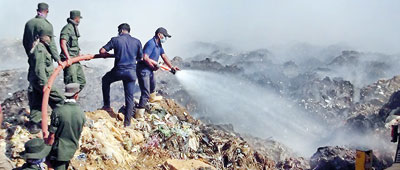News
Hazardous Badulla smog still hugs town
View(s):By Anushiya Sathisraja

Attempts to douse the emanating fumes. Pix by Palitha Ariyawansha
Days after a blaze broke out in five acres of trash mounds in Badulla, the smoke billowing from the conflagration continues to be a health hazard with authorities shutting down eight schools and hospitals and government dispensaries witnessing a rise in the number of patients.
Garbage dumped here is often mixed waste, including paper, plastic containers, bottles, cans and at times electronic goods together with decomposable wastes from food, dead animals, construction debris and even industrial waste.
The thick smog from the garbage dump has spread across Badulla town.
At the Badulla Base Hospital alone about 30 people have been treated for smoke inhalation. A hospital official said because plastics and polythene had been incinerated in the fire, gases such as methane and other hydrocarbons are being released and that carcinogenic dioxins could also be released. He said that because Badulla lies in a basin it is taking a long time for the smoke to dissipate.
“If you have symptoms such as breathing difficulties, throat pain, eye irritation visit doctor immediately, do not treat yourselves at home,” the official said.
The Badulla Urban Council has urged residents to refrain from inhaling the smoke that is spewing out of the garbage dump. The garbage dump spread over five acres had dried up and caught fire.
The amount of garbage burned in remote villages and crowded megacities is rising as more people worldwide are consuming more goods.

“Air pollution across much of the globe is significantly underestimated because no one is tracking open-fire burning of trash,” Senior Lecturer at the Open University of Sri Lanka, R.W. Sumathipala said.
The pollutants from trash fires are all toxic to humans depending on their concentration, he said.
The Uva Provincial Department of Education has ordered the temporary closure of eight schools – Badulla Dharmadutha College, Uva Maha Vidyalaya, Viharamaha devi Girls’ School, Badulla Central College, Visakha Girls School, Sujatha Girls School, Al Adam College and Al Isman Primary School in Badulla until next week.

| UDA considers waste-to-energy options as WP garbage mountains rise The Urban Development Authority (UDA) has received eight proposals for the project “Waste-to-Energy” (WTE) and two proposals will be selected for the Karadiyana and Meethotamulla garbage dump site, a senior UDA official said. Garbage collection and disposal has become a critical service in the country, especially in the Western Province where more than 1,000 tons of garbage collects every day. Mountains of garbage landfill in major cities such as Colombo, Kandy and Ratnapura are causing major environmental and health problems in the surrounding community. “There is insufficient capital investment to carry out an effective waste management strategy”, said UDA Chairman Dr. Jagath Munasinghe. He said the proposals received for dealing with waste at the Karadiyana and Meethotamulla dumps would be evaluated by a committee of university professors, ministers, solid waste sector committees and other experts. Once selected, the projects should be initiated at once and be completed within two years, he said. Experts point to a reluctance in creating and implementing laws and the lack of political commitment at all levels of government in dealing with garbage disposal, as well as an absence of accountability in service delivery and poor technical know-how. Waste generation is increasing by 1-2 per cent per day and it is predicted that by 2050 waste generation in the Western Province will increase to up to 5,800 metric tonnes a day. “This is the biggest challenge we have to face in the years to come and we are in the process of facing this challenge effectively by introducing short-term, medium-term and long-term programmes for waste management in the Western Province,” Dr. Munasinghe said. By 2018, Western Province administrators hope to be turning at least 500 metric tonnes per day of perishable garbage into compost. “Composting is the best way of using Municipal Solid Waste (MSW) as a resource as 30 per cent of the garbage collected by local government bodies in Sri Lanka consists of short term biodegradable waste which can be easily converted into compost,” an official said. He pointed out that there was a “huge advantage” in having a composting facility at Karadiyana because that dumping site receives around 500 metric tonnes of MSW a day. It is learned that a private company has approached the UDA over using garbage waste to power two biogas power plants in Sri Lanka using up waste from animal and vegetable byproducts, household bio-waste, organic waste, sludge, industrial and commercial waste. A spokesman said with the planned 20MW plants in use only 4 per cent of the original municipal waste would be classified as hazardous ash. |

